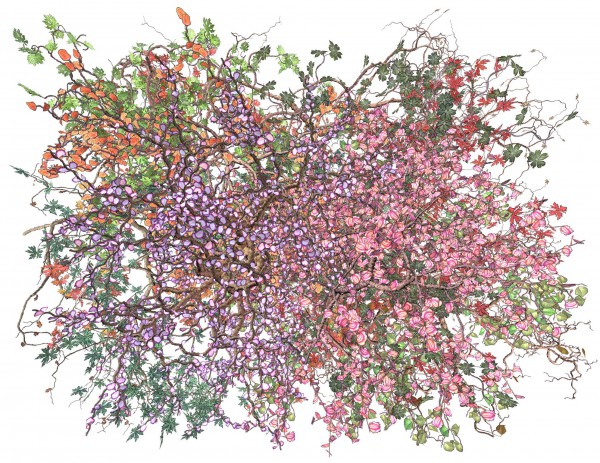
Jennifer Steinkamp, Diaspore 1 (2014). Video installation, dimensions variable; Edition of 3.
Photo: Courtesy of the artist and Lehmann Maupin, New York and Hong Kong.
Jennifer Steinkamp’s videos—enormous projections of digitally rendered trees, flowers and abstract forms going through cyclical, looping movements and transformations—have always teemed with plant life. But in her newest piece, Diaspore (2014), she broaches the subject of death. That work, along with 2013’s Bouquet, is making its debut at Lehmann Maupin’s Hong Kong space this month.
“I’ve never really dealt with death the way Dutch painters did—I really love those paintings,” Steinkamp says of her work’s affinity with Golden Age Dutch still lifes. “So it’s nice to be able to start to go there.”
In Diaspore, clusters of blooming and leafy tumbleweeds collide and explode, releasing clouds of spores as they whither and wilt before the animation reverses and, like a dying tree being reborn from its seeds, the tumbleweeds grow back into a tangled latticework. The piece marks a thematic departure for Steinkamp, while building on the type of large-scale, digitally composed floral imagery she’s been making since 2002. Her interest in these abstracted organic forms arises from a surprisingly specific, politically charged, and very inorganic event.
Jennifer Steinkamp, Bouquet 1 (2013). Video installation, dimensions variable; Edition of 3.
Photo: Courtesy of the artist and Lehmann Maupin, New York and Hong Kong.
“The first piece with plants was a piece called Jimmy Carter, which was a reaction to us going to war in Afghanistan,” Steinkamp says of her initial use of computerized plants. “And I actually thought of the flowers in that piece as stripes. It was really more abstract at the time. I’ve always worked with cyclical kinds of animations, and plants seem to have a couple ways of being cyclical. The software also has this ability to work with plants , so it all kind of came together.”
The show’s other piece, Bouquet, upends the imagery of tiny, delicate, and static arrangements of flowers familiar from the still life paintings that its title invokes. “I like the idea of a bouquet of trees,” Steinkamp says, “it’s sort of funny.” The video features an enormous and shimmering bunch of trees, each with distinct flowers, leaves, and branches—some more life–like than others. It evokes a dense and diverse forest; yet set in a vacuum-like landscape with no other elements, it’s also surreal and characteristically abstract.
“All my flowers are all real flowers, but the trees are not real trees,” Steinkamp explains. “It’s kind of a limitation of the software; it’s really great for flowers, but for specific trees it’s kind of difficult. That’s not a really good reason, but I like that the trees are made up.”
Jennifer Steinkamp, Madame Curie installation view, Museum of Contemporary Art San Diego, January 23-June 26, 2011.
Photo: Courtesy of the artist and Lehmann Maupin, New York and Hong Kong.
The piece’s absurdist humor must be a strange fit at the American Consulate in Guangzhou, China, where another edition of Bouquet has been on view since 2013. “For me, adversity often leads to something good and sometimes better than originally what it was going to be,” Steinkamp says of the challenge of creating a new piece specifically for the Skidmore, Owings & Merrill–designed consulate. “And it certainly worked out well for that space.”
Diaspore, with its themes of death and rebirth but also displacement and migration, follows a similar logic to one of Steinkamp’s most ambitious works to date, the large-scale projection Orbit (2008–12), in which a tangled web of branches, leaves and flowers cycles through the four seasons. That work was recently featured in Steinkamp’s exhibition at the Contemporary Art Museum in St. Louis, the latest in a string of solo shows at a US museum. As for how Diaspore will be received by viewers in Hong Kong, the artist is uncertain but optimistic.
“I’m always curious about that,” she says. “When you put work into a different culture it’s really fascinating, so I guess we’ll see.”
“Jennifer Steinkamp: Diaspore” runs February 13–March 22 at Lehmann Maupin Hong Kong.